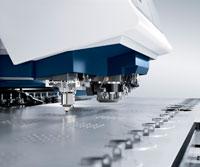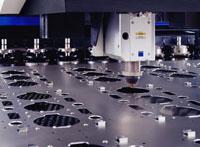TruPunch Product Manager
- FMA
- The Fabricator
- FABTECH
- Canadian Metalworking
Categories
- Additive Manufacturing
- Aluminum Welding
- Arc Welding
- Assembly and Joining
- Automation and Robotics
- Bending and Forming
- Consumables
- Cutting and Weld Prep
- Electric Vehicles
- En Español
- Finishing
- Hydroforming
- Laser Cutting
- Laser Welding
- Machining
- Manufacturing Software
- Materials Handling
- Metals/Materials
- Oxyfuel Cutting
- Plasma Cutting
- Power Tools
- Punching and Other Holemaking
- Roll Forming
- Safety
- Sawing
- Shearing
- Shop Management
- Testing and Measuring
- Tube and Pipe Fabrication
- Tube and Pipe Production
- Waterjet Cutting
Industry Directory
Webcasts
Podcasts
FAB 40
Advertise
Subscribe
Account Login
Search
Is a laser/punch machine right for you?
The equipment's capabilities can make an impact in the right fabrication environment
- By Mike Kroll
- July 16, 2012
- Article
- Laser Cutting

Figure 1: Laser cutting/punching combination machines have been around for more than 30 years, but today’s machines are nothing like those of earlier generations. Perhaps most important has been the advancement of laser resonator technology that delivers faster cutting speeds and more powerful lasers. The laser cutting head has evolved, too, so that it actually can cut over formed areas in some circumstances. Photos courtesy of TRUMPF Inc.
Most fabricators evaluate a part they need to process and think, “That’s a punch part, or that’s a laser part,” but it is not always so black and white. Often the part can be fabricated efficiently with either processing technology.
That leads to two important questions:
- How do I determine if my shop should use both technologies on one part?
- What must we consider before investing in laser/punch combination technology?
A Combination of Answers
Those questions can be answered with a general discussion of what laser/punch combination machines do. In fact, they are becoming increasingly popular because of their flexibility (see Figure 1) and reliability of automation. The machines may allow you to make parts faster and at a lower cost. Continuous improvement techniques focus on the elimination of unneeded material handling, and the design of the laser/punch combination machine supports such efforts because it eliminates the need to move parts from one machine to another. When blanks or parts have to be moved between machines, inaccuracies can occur because of misalignment of sheets and costs may increase because of the additional handling of parts.
Also, laser/punch combination machines can eliminate some secondary operations. For instance, if the machine has a tapping tool, you don’t have to send the part to a hardware-insertion station once the part exits the combination machine.
Before delving any further into what combination machines can offer, it’s first necessary to understand the fundamentals. Combination proc-essing machines have a punching head and a laser on one machine frame. The two technologies cannot be used at the same time. Clamps hold the material, and the sheet moves under a fixed punch or laser head for processing. This generally limits material thicknesses to 0.25 inch.
The punch is used to process holes, create forms (flanges up to 1 in. high), tap extrusions, and fabricate the entire part if laser cutting is not needed. The laser is best used to process parts with complex geometries or with edges in need of a clean finish (see Figure 2). It is also a useful tool for developmental parts because it can quickly produce just a few parts or special sizes without the need to build or order tooling.
Taking the offset between the punch and laser head into consideration, you can maintain part tolerances of ±0.004 in. because the part does not need to be moved from one process to another to complete it. Additionally, the punching proc-ess can leave a burr on the bottom of a part, and thicker materials may show match overlap marks. These can be eliminated by processing the part with the laser if a clean, burr-free edge is needed.
As metal fabricators process more low-volume, high-variety orders, they are still looking to achieve the fastest throughput possible for their customers. Laser/punch combination technology fits this scenario well and, in many circumstances, can alleviate setbacks in processing.
For example, if a single-hit tool is not available for processing contours and slots, you can use the laser. The punch tooling is no longer required.
In another example, what if a certain hole size or geometry is needed and the lead-time for receiving the tool is three days? The deadline delivery date is not at risk because the flexibility of the laser allows the geometry to be produced instantly.

Figure 2: A laser produces a smooth edge without burrs on most cuts, which is desirable for exterior parts or holes used for cable connections.
With a laser/punch combination machine, you no longer need a tool for every part geometry and can avoid purchasing unnecessary tooling. Although every metal fabricator’s workload is different, in general, a shop can expect an average 30 percent reduction of its punch tooling inventory with a combination machine.
You should not limit your tooling inventory to simple geometries, either. It is still faster and less expensive to punch rather than cut with the laser. In addition, the punch speed achieved with a combination machine is equivalent to that of a stand-alone machine. Because punching is so efficient, routinely used tools for features such as keyholes, single and double D shapes, and computer ports holes are still worth keeping in the tooling inventory.
Automation and Design Opportunities
With automation components added to combination machines, parts processing becomes an unmanned operation, something that would be expensive to replicate with separate laser cutting and punching machines. In this lights-out scenario, raw material is loaded from a platform or storage tower and introduced to the machine for processing. A robotic arm removes individual parts from sheet skeletons and palletizes them on an unload platform or on movable carts.
The quantity, location, or orientation of parts can be tailored to each pallet or cart, which creates an opportunity for you to prepare kits of parts for specific assemblies. This is a key element because processing can take place without interruption. Pallets with finished goods can even be placed back into a storage tower for later use.
The automation used with a combination machine also eliminates potential damage to the parts and mistakes related to sorting left- and right-hand parts because manual intervention is not required.
Benefits related to combination processing are not limited to shop floor efficiencies. Part designers can find additional freedom.
Parts intended for a punch machine generally are rectangular with sharp corners and round hole reliefs that allow bending in the corners. With a combination machine, the integrated laser supports relief corners with multiple radii without additional tooling. For example, very thin notches of less than half the material thickness can be processed because the laser can cut the geometry.
Answering the Important Questions
With this flexibility in mind, let’s revisit questions posed earlier.
How do I determine if my shop should use both technologies on one part?
In general, hole-intensive parts with complex forms are good candidates for a combination machine (see Figure 3). The punch will produce standard holes much faster than they can be laser-cut, but the laser is able to process complex geometries that are not well-suited to punching techniques. The laser is also better for parts with many blending contours or different radii that can require excessive tooling to process the part or if a single punch process on the contour might leave unwanted nibble marks. You may also need the laser processing capacity of the machine if smooth and clean edges are required for an aesthetically appealing part.

Figure 3: This part is a good fit for the laser/punch combination machine. The complex forms and plethora of similarly sized holes are perfect for the machine’s punching capabilities. Meanwhile, the laser is the tool of choice to create the larger opening with the smooth edges.
Examples of parts processed with combination machines can be found in our everyday life. Many home kitchens have been updated to incorporate stainless steel appliances, and these appliances contain parts featuring louvers or offsets, hinges, and tapped holes—perfect candidates for punching operations. The same appliance part also may require a clean edge free of burrs and nibble marks to meet the safety requirements of the industry and the aesthetic demands of the consumer. This is achieved with the laser. Combination machines are highly successful in creating edges and contours that are efficient, precise, and clean for the most attractive and best possible finished part.
What must we consider before investing in laser/punch combination technology?
You need to determine if your shop has the right product mix that will enable you to maximize the equipment’s production capabilities. You also should consider how automated material handling can increase productivity and performance as well as maximize the full potential of the machine.
Finally, let’s end with one more commonly asked question:
If I had to choose one fabrication tool to process parts, what would it be?
The answer has always been the same: combination technology. For sheet metal fabrication, punch and laser processing on a single machine gives you the ability to process every possible part.
About the Author
Mike Kroll
Farmington Industrial Park
Farmington, CT 06032
860-255-6068
Related Companies
subscribe now

The Fabricator is North America's leading magazine for the metal forming and fabricating industry. The magazine delivers the news, technical articles, and case histories that enable fabricators to do their jobs more efficiently. The Fabricator has served the industry since 1970.
start your free subscription- Stay connected from anywhere

Easily access valuable industry resources now with full access to the digital edition of The Fabricator.

Easily access valuable industry resources now with full access to the digital edition of The Welder.

Easily access valuable industry resources now with full access to the digital edition of The Tube and Pipe Journal.
- Podcasting
- Podcast:
- The Fabricator Podcast
- Published:
- 04/16/2024
- Running Time:
- 63:29
In this episode of The Fabricator Podcast, Caleb Chamberlain, co-founder and CEO of OSH Cut, discusses his company’s...
- Trending Articles
AI, machine learning, and the future of metal fabrication

Employee ownership: The best way to ensure engagement

Dynamic Metal blossoms with each passing year

Steel industry reacts to Nucor’s new weekly published HRC price

Metal fabrication management: A guide for new supervisors

- Industry Events
16th Annual Safety Conference
- April 30 - May 1, 2024
- Elgin,
Pipe and Tube Conference
- May 21 - 22, 2024
- Omaha, NE
World-Class Roll Forming Workshop
- June 5 - 6, 2024
- Louisville, KY
Advanced Laser Application Workshop
- June 25 - 27, 2024
- Novi, MI


























